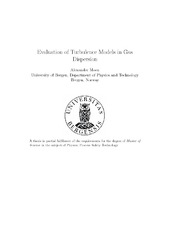Evaluation of Turbulence Models in Gas Dispersion
Master thesis
Permanent lenke
https://hdl.handle.net/1956/12577Utgivelsesdato
2016-06-01Metadata
Vis full innførselSamlinger
Sammendrag
Several earlier model validation studies for predicting gas dispersion scenarios have been conducted for the three RANS two-equation eddy viscosity turbulence models, the standard k-ε (SKE), Re- Normalisation group k-ε (RNG) and Realizable k-ε (Realizable). However, these studies have mainly validated one or two of the models, and have mostly used one simulation case as a basis for determining which model is the best suited for predicting such scenarios. In addition, the studies have shown conflicting results as to which model is ideal for dispersion simulations. The aim of the study was therefore to assess three well-known RANS two-equation eddy viscosity models, in four different gas dispersion cases. The purpose was to evaluate the models' behaviour compared to experimental data, in order to see which of the models was best suited for predicting dispersion scenarios. The cases used in the thesis were: CO2 dispersion in a cross- wind, neutral dispersion in an urban environment, hydrogen jet impinging on a surface, and a dense jet dispersion on an industrial site. All simulations were conducted with a CFD software that partially resolved the geometry, and was designed for large complex multiscale flow scenarios. The most important parameters for assessing the turbulence models were accuracy of the simulation results and computational time used. Overall, SKE seemed to be the best-suited model for 3 out of 4 cases, and provided good results for all the scenarios. However, RNG also provided reasonably results in all cases, in a practical timeframe. Realizable was the model that commonly used longest computational time, and was found least suitable for 3 out of 4 cases.
Utgiver
The University of BergenOpphavsrett
Copyright the Author. All rights reservedBeslektede innførsler
Viser innførsler beslektet ved tittel, forfatter og emneord.
-
Modeling of land–surface interactions in the PALM model system 6.0: land surface model description, first evaluation, and sensitivity to model parameters
Gehrke, Katrin Frieda; Sühring, Matthias; Maronga, Bjørn (Journal article; Peer reviewed, 2021)In this paper the land surface model embedded in the PALM model system is described and evaluated against in situ measurements at Cabauw, Netherlands. A total of 2 consecutive clear-sky days are simulated, and the components ... -
Large Language Models are Not Models of Natural Language: They are Corpus Models
Veres, Csaba (Journal article; Peer reviewed, 2022)Natural Language Processing (NLP) has become one of the leading application areas in the current Artificial Intelligence boom. Transfer learning has enabled large deep learning neural networks trained on the language ... -
Large scale collective modeling the final "Freeze out" stages of energetic heavy ion reactions and calculation of single particle measurables from these models
Nyiri, Agnes (Doctoral thesis, 2005-09-30)
